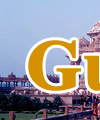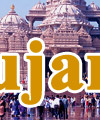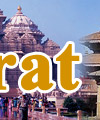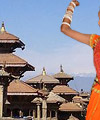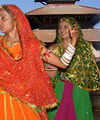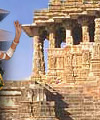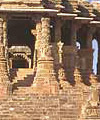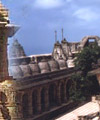|
Excursion
Monuments
[ Aina
Mahal | Prag Mahal | Lallubhai
Haveli | Khapra Zaveri Palace | Laxmi
Vilas Palace | Kusum Vilas Palace | Kali
Niketan | Palaces at Danta | Bhavani
Villa | Dabargadh | Navlakha
Palace | The Riverside Palace | Halvad
Palace | Lakhota Palace | Uparkot
| Vijay Vilas Palace | Art Deco
Palace | Rani Ki Vav | Grishmabhavan
| Huzoor Palace | Bohra Havelis
| Digvir Niwas Palace | Raj Mahal
| Hawa Mahal | Ranjit Vilas Palace
| Darbargadh ]
Aina
Mahal
Rao Lakhpatji (1707-61 AD) constructed Aina Mahal in 1750 AD. He
was a great patron of art, architecture, music and literature. Aina
Mahal is a unique example of an Indian palace built in the mid-eighteenth
century with European influence. Ramsinh Malam designed it. Ramsinh
stayed in Holland for 17 years. He was trained in the crafts of
clock making, cannon fabrication, enameling, tile making and architecture.
On his return, he undertook the mirror work, tile work and fountains
at Aina Mahal. Aina Mahal is a part of a large palace complex- it
is a two storied building with Darbar Hall, hall of mirrors, and
suites for royal family.
Top
Prag Mahal
Rao
Pragmalji II (1838-76 AD) undertook the construction of Prag Mahal.
He appointed a famous architect- Colonel Henry Saint Wilkins to
design Prag Mahal. Colonel Wilkins had designed Deccan College,
Sasoon Hospital, Ohel David Synagogue, St. Paul's church at Pune,
Frere Hall at Karachi and secretariat at Bombay.
Prag Mahal was built in 10 years at a cost of 20 lakh rupees. It
is built in the Italian Gothic style, having a large Darbar hall,
big rooms, wide verandahs and a 45-meter high lofty bell tower.
The palace was built using a variety of Indian artisanship combined
with European architectural design.
Top
Lallubhai Haveli
Built in 1791 A.D., by Lallubhai, an ex-Divan of the last Nawab
of Broach, it is mainly a one-storied building with a small bungli
(room) on the second floor. Lallubhai used to hold his court here.
It has a front of carved wood, very richly designed. On the second
floor, there are arrangements for placing matchlock guns. According
to local tradition, there are underground passages in the haveli.
Top
Khapra Zaveri Palace
The ruins of Khapra Zaveri Palace are located on the way from the
base to Machi. From its terrace, one can have a fabulous view of
the origin of Vishwamaitri River. Atak gate is one of the nine gates
that lead to the hilltop. It has two catapult stands for hurling
stones at the enemies. Other monuments from Machi to hilltop are-
Makai Kothar, a granary with the fort, Kalikat Temple and a shrine
of Muslim Saints Sadanshah.
Top
Laxmi Vilas Palace
One of the largest and, perhaps the finest, specimen of Indo-Saracenic
architecture in the country, the Laxmi Vilas is home to Ranjit Singh
Pratap Singh Gaekwad, heir to one of the wealthiest princely houses
in India. Maharaja Sayaji Rao Gaekwad III (1875-1939) is a legend
in the State and he was the adopted son of Queen Jamnabai, he took
Baroda to a wonderful era. Sayaji Rao began constructing the Laxmi
Vilas Palace in 1878 naming it after his first wife, a princess
of Tanjore. The dancers, whom the princess brought with her as part
of the dowry, are said to be responsible for making Bharatanatyam
popular in the North. Beautiful statuary, marble fountains, Moorish
arcades and stained glass windows adorn the structure. It is quite
a long drive from the huge wrought iron gates, mounted with the
royal emblem, to the doorway of the palace.
Top
Kusum
Vilas Palace
The Kusum Vilas Palace was design by a famous architectural firm
of Bombay - Bhatkar & Bhatkar, in the early 20's. The design
concept was to create a palace in a harmonious fusion of the architectural
style of Champaner with modern amenities of an elevator and other
functional requirements. A large porch, arcaded facade and balanced
architectural treatment of the 5 storied central wing with receding
volume, capped with a dome lends majesty to the palace. The British-made
elevator has a foyer at ground level, enclosed by series of exquisitely
carved stone jalis bringing in an ethereal light effect.
The interiors are a blend of east and west. The carved pilasters,
friezes gilded with real gold are replicas of such architectural
elements at Champaner. The grand reception room on ground floor
has large doors, carved false ceiling, French furniture, Belgium
mirrors and superb Italian marble statues. The wall paintings by
an Indian artist, depicting the picturesque settings of Chhota Udepur
and previous capital Mohan, are most remarkable.
Top
Kali Niketan
Kali Niketan, originally called Nahar Mahal, the palatial
mansion was built about 100 years ago as the summer residence of
the royal family along the River Orsang. Attractively set in fruit
orchards, the mansion has fountains in the forecourt and in the
courtyard. The palatial mansion has terraces with good views of
the gardens. Other architecturally beautiful royal buildings now
used, as public buildings and government offices are Collector's
office, Rani Mahal, college and ITI building.
Top
Palaces at Danta
The two palaces are located at the lower end of the hill, but higher
than the town. The entire old royal palace campus was fortified
in the past, housing several buildings within it. The huge impressive
gate leads one into the royal campus. The old palace is clustered
around a series of courtyards, interconnected by a series of gates.
The first court is surrounded by a low height structure, originally
acting as an administrative block.
In the same court, the other interesting structure is the family
shrine of Goddess Ambaji built in the Rajput style of architecture,
inspired by the royal architecture of Rajasthan. This four-storied
structure has the shrine in one corner, but instead of a temple-like
structure, it resembles the small Darbargadhs of Rajasthan. The
opaque and plain structure at the lower level becomes more decorative
at the top by the sensitive use of several architectural elements
like horizontal friezes, carved brackets, deliberately carved stone
jalis, jharokhas, decorated parapets and domes.
The second gate leads to another courtyard of the residential wing.
The profusely carved floral pattern on the red stone entrances is
in the style of the royal palaces and havelis of Bikaner. Arcades
and a dome surround the inner courtyard - a typical feature of Danta
palaces- caps the stair tower.
Top
Bhavani
Villa
Another palace, Bhavani Villa, the present residence of the royal
family is located on a higher elevation than the old palace. The
palace is built at several levels on a hill edge with a skyline
of domes, offering a fantastic view of the Aravalli hills. The ex-ruler
of Danta is a great wildlife enthusiast and also runs a stud farm
of Marwadi horses.
Top
Dabargadh (Dhoraji)
The massive fort wall has several bastions, four main gates and
three Baris (small gates). The four main gates are - Kathiawadi
Darwaza in east, Porbandar Gate in west, Halar Gate in north and
Junagadh Gate in south. The smaller gates are- Darbari Bari, Bhimji
Bari and Sati Bari.
Darbargadh is located at the highest point in the town. Darbari
bari is the beautiful gate leading to Dabargadh adorned with a jharokha,
resting on rackets of 4 elephant statues in different poses. A beautifully
carved entrance gate leads to the Darbargadh in the middle of a
courtyard. Darbargadh is three-storied. There are images of sitting
lions in different postures on long eaves, profusely carved pillars,
horizontal friezes, decorative kanguras and windows framing skyline.
It is designed like a jewel box-in the same architectural style
of Navalakha Palace at Gondal.
Top
Navlakha
Palace
One of the oldest and beautiful of Gondal palaces, the Navlakha
Palace complex (17th century), is situated on a riverbank. It is
built on a grand masonry base, rising the monumental scale of at
least 30-meter above the riverbed. The high gateway with the clock
tower from the town side leads to the palace. The entrance opens
to a huge space with administrative block on the right and a grand
staircase with balustrade on the extreme left corner. The staircase
leads to the intricately carved pavilion on the open terrace.
The grand Darbar Hall, with a series of huge windows opening onto
a long balcony supported by intricately carved brackets, overlooks
the river. Darbar Hall has the large chandeliers, stuffed panthers,
gilt wooden furniture and antique Belgium mirrors. The private palace
museum displays artifacts, gifts and messages received by Sir Bhagwatsinhji
on his 50th Birthday.
Top
The
Riverside Palace
The Riverside Palace is located at the edge of the Godali River.
It is constructed in colonial style of architecture, amidst a garden
with huge trees. The living rooms are decorated in European taste,
while the Indian rooms have brassware, beadwork and paintings in
typical Indian style. The series of galleries and terraces of the
palace building bring nature close to the visitors of this heritage
hotel.
The rulers of Gondal were great lovers of automobiles and one can
see several vintage and classic cars in the royal garage. Two royal
rail saloons of the Gondal State were renovated, keeping the original
decor and are available for accommodation in the Orchard Garden
Palace.
Top
Halvad
Palace
The Halvad Palace campus has all the elements of Rajput palaces-
zenana, hall for public audience, temple of family goddess, pleasure
garden and administrative offices. The entry to the Halvad Palace
is from the town-side. The beautifully carved entrance gate leads
one to a huge courtyard. The formal square plan of two- storied
palace structure, adorned with exquisitely carved wooden columns,
brackets, friezes and jails with geometric patterns defines the
courtyard. Four raised pathways, from the center of each side, meet
in the middle of the courtyard at the base of the seven-storied,
octagonal towers. These towers are with jharokhas overlooking all
eight directions. From the top of this tower, on a clear day, one
can see the surrounding villages. Therefore, it is popularly known
as Jhalawad Darshan or Ek-Dandia Mahal.
The long facade with carved stone jharokhas brings in cool breeze
as it overlooks the lake. The jharokhas were the favorite sit-outs
of the royal women. On the full moon nights, the terrace was used
for private royal gatherings. Even today, one can see beautifully
carved sit-outs of sandstone on the terrace. In short, the architecture
of the palace is a perfect synthesis of two natural materials, stone
and wood. This Royal Palace at the edge of the town, on the bank
of the Samatasar Lake is the finest example of wooden architecture
of royal palaces of Gujarat.
Top
Lakhota
Palace
The Lakhota Palace in the shape of large bastion is situated on
an island, in the middle of the Lakhota Tank. An arched stone-bridge
with balustrade connects the Lakhota Palace with the town. It was
constructed as a famine relief work in 1839-45 AD. The elaborate
entrance gateway with carved jharokhas at upper level, overlooking
the tank and the stark black wall at the base, give it a look of
invincible fortification. It has been converted into a museum in
1946. It has a fine collection of sculptures, coins, inscriptions
and copper plates and the skeleton of a whale. Jadeja Rajputs adorns
the walls with frescos depicting scenes of battle fought against
various enemies. On the bank of the Lakhota Tank, near Khambholiya
Gate, another interesting bastion like structure is Bhujiyo Kotho.
Top
Uparkot
There are two fortifications: the fort walls surrounding the town
and Uparkot in the west. Uparkot, an ancient citadel located on
the higher level of the town, was a stronghold of Mauryans and Gupta
Empire and is said to have survived 16 sieges in the last 1000 years
due to its strategic location and difficult access. The entrance
of Uparkot has a fine specimen of Hindu Toran, leading to flat land
dotted with archeological sites. The major sites are Buddhist caves,
Baba Pyara caves (2nd century), Adi-Kadi Vav, Navghan Kuvo and Jami
Masjid.
Top
Vijay
Vilas Palace
The center of attraction at Mandvi is the Vijay Vilas Palace. It
is set in the middle of well-laid gardens with water channels and
marble fountains. The architect and artisans from Jaipur designed
and constructed the palace in 1920 AD. The palace has all the elements
of Rajput architecture. It is largely designed on the plan of palaces
of Orchha and Datia. The central high dome on the pillars, the Bengal
domes on sides, the windows with coloured glass, carved stone jalis,
domed bastions at the corners, extended porch and other exquisitely
stone-carved elements, make the palace worth visiting. This is an
example of the traditional skill of artisans of early 20th century.
The Vijay Vilas Palace has its own private beach, maintained in
an Eco-friendly manner to preserve its pristine beauty. For these
reasons, this palace has been used as the setting in many Hindi
films. It has now become a popular tourist destination. Mandvi has
some very beautiful houses belonging to rich merchants with stone
carving and plaster decorations. Their architectural style reflects
the fusion of Indian and European styles of architecture.
Top
Art Deco Palace
Art Deco Palace (1931-44 AD) is a marvelous example of influence
of last phase of art deco movement of Europe. It is low and two
storied in banded horizontal fenestration, curves and bays, which
resemble the London underground stations of Charles Holden. The
palace has six dining rooms, and fourteen bedrooms. The decorated
subterranean bedroom, with many erotic murals and a bathroom made
from seashells are also noteworthy.
Top
Rani Ki Vav
Rani Ki Vav is an excellent example of subterranean architecture
of Gujarat. This Vav was constructed by Udaymati, the queen of Bhimdev
(1022-63 AD). The exquisitely carved sidewalls, pillars, beams,
series of steps and platforms lead to the elaborately carved water
well. Finely chiseled sculptures of maidens and Hindu deities, religious
motifs and geometrical patterns beautify every corner. Rani Ki Vav
represents the finest of the Indian sculptures and architecture.
Top
Grishmabhavan
Grishmabhavan is an impressive pavilion built for the eighteenth-century
poet Raja Sartanji Choro. It is built in Rajput style in the midst
of the garden. Each side of the garden represents a different season.
The pillars with images of musicians, profusely carved foliated
arches and a single dome at the top gives an idea of bygone days,
when Rana Sartanji used to compose poems in Braj bhasha, sitting
under this pavilion.
Top
Huzoor
Palace
Huzoor Palace is located at the end of Marine Drive, in a huge campus.
The sprawling palace, built in the European style with sloping roofs
is a horizontal structure with several wings and big windows, overlooking
the sea. The wings are interspersed with the back and front yards,
bringing nature and the building together by gardens and fountains.
The semi circular porticos with neo classical pillars, decorated
entrance gate and commanding view makes it a must for the visitor.
Other such examples of royal and public heritage buildings from
the colonial period are public library, old Raj Mahal (now a college),
Victoria Jubilee Madresa, Collectorate, Bhavsinhji High School,
Natwarsinhji Sports Club.
Top
Bohra
Havelis
Sidhpur is a major center of the Bohra Muslims from few centuries.
The Bohras are a rich and cultured community spread all over the
major cities of the world. They are deeply attached to their native
town of Sidhpur. They regularly visit the town for important social
ceremonies. About a century ago, they built very beautiful mansions
in a typical architectural style, from the wealth earned abroad.
The well laid out paved streets, services lanes, mosques, perfect
arrangement of row houses with profusely decorated facades using
a common architectural style is a direct outcome of the collective
vision of the Guilds of Bohra merchants. It will be a wonderful
experience to visit Boharwad. It is a perfect example of urban design
in the middle of chaotic Indian urbanization.
Top
Digvir
Niwas Palace
The Digvir Niwas Palaces is one of the finest examples of royal
architecture in the early 20th century. The approach to the palace
is through a beautiful plaster decorated gate and the octagonal
chhatris on both sides of the entrance gate give it an imposing
look.
The Digvir Niwas Palace is a low profile linear building, with
ashlar stone masonry. All the openings are defined by white decorative
plaster, creating interplay of textures. The entire façade
has several architectural elements like carved balustrade, arches,
brackets, pediments, columns, and semi circular and octagonal verandahs,
curved overhangs protecting windows with stained and coloured glass,
with a steep sloping Mansard roof on the top arranged in a creative
design scheme to create an appealing edifice. The setting of the
palace building and the campus layout seem to have been inspired
by British castles and French chateaux of the European aristocracy.
Top
Raj Mahal
The late H. H. Balsinhji built the Raj Mahal in the 19th century.
The sprawling campus of 14 acres has cricket pitches, tennis courts,
gardens, fountains and lily ponds. The palace is designed around
a central pillared courtyard with marble fountains, statues and
carved marble furniture. The Darbar Hall has many life-size paintings
of past rulers and the royal throne. The drawing room is decorated
with crystal chandeliers and the Shish Mahal has Belgian mirrors.
Every nook and covered by intricate decoration.
Top
Hawa
Mahal
The Hawa Mahal literally means 'wind palace'. It was an ambitious
project, abandoned halfway by the Wadhvan rulers. The incomplete
structure stands outside the fort and is a building worth studying
for its architecture, showing different stages of construction.
Even today, around the Hawa Mahal, one can see Sompura artisans
carving stones for various Hindu and Jain temple projects in India
and abroad.
Top
Ranjit
Vilas Palace
Ranjit Vilas Palace is a very eclectic building, a bold attempt
to synthesize various architectural styles. The front and back facades
are appropriately designed in response to its location. The receding
volumes, on the front, creating a series of terraces culminated
in two beautiful designed pavilions with gothic arches. The back
facade, on the town side, really establishes the palace as in impressive
landmark. The seven-storied central clock tower capped by a Mughal
dome and two five storied high bastions, at the both corners, culminate
in hexagonal chhatris. The facade has arcades of arched Victorian
windows, Italianate pillars, Gothic arches and classical parapets.
A massive Dutch roof spans the central wing of the palace. A double
staircase is the unique feature of the interior of this palace,
where the royal women could ascend and descend without being seen
by men. A similar double staircase at Chateau de Chambord, Loire,
France, dating to the Renaissance period, inspired this staircase.
Ranjit Vilas Palace has memorable collection of swords, shields
and daggers, 95 species of stuffed animals, dueling pistols, pig-sticking
spears, silve- lined chests, silver-platted howdahs, thrones, painting
and portraits. The palace has magnificent spiraling marble staircase,
stained glass galleries, and chandeliers and period furniture. The
garage, on the grounds of the palace complex, has Vintage cars like
the 1921 Rolls Royce Silver, Ghost, some imposing American cars
and horse drawn carriages. The palace also has a stable of Kathiawadi
horses. There are large grounds with beautiful Italian fountains.
Top
Dabargadh(Porbandar)
Rana Sartanji built Darbargadh, the fortified palace, with a huge
carved stone entrance gate flanked by high turrets and massive wooden
doors. It is a typical example of such royal enclosures situated
within the town of Gujarat. The nearby edifices on the left of the
entrance are also good examples of large mansions with courtyards
and intricately carved wooden elements.
Top
General Information on Monuments in Gujarat - India
|
